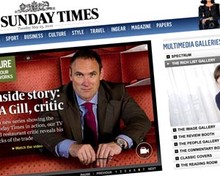
The launch sees a new design for the Times website, a rebranding as TheTimes.co.uk rather than Times Online and a standalone site for the Sunday Times.
"There's been a key wish that both papers should have their own identity online. It [building the sites] has let us think about the sites and what they do and approach them in a very different way but a way that's not confusing to people who might have been coming to the Sunday Times and Times for some time," said Tristan Davies, executive editor of the Sunday Times, at a pre-launch event last night. The sites are intended to have a distinctly different feel from one another, said Davies, whose Times colleague Daniel Finkelstein said the new sites are "a step forward in how newspapers project themselves online".
More details of the new sites' design, images and a video introduction are available below.
The sites' homepages will be freely available; going beyond this point will require an online subscription priced at £1 a day or £2 a week for both sites, or a print subscription deal. Clicking through to any other content on the site currently redirects users to a Times+ login page, where they can register for a subscription or sign up for an initial free trial of the new sites. The paywall covering both sites is expected to begin in four weeks, a spokesperson for News International said last night.
On Radio 4 last week, Sunday Times editor John Witherow said he expected his site could easily lose 90 per cent of traffic upon introducing the paywall and last night questions were asked about the loss of referrals to the sites from search engines and social media sites.
The homepages of both sites will be crawled by search engines, but articles and content that do not feature on these pages will not be included. Where material that is indexed will appear in search results is as yet unknown, but is likely to be seriously effected by the introduction of the paywall, added Gurtej Sandhu, digital director of the Times.
Finkelstein said he and other columnists would continue to circulate and share links to their work via social networks such as Twitter, despite directing followers to an item beyond a paywall. Without a different revenue model, those articles and columnists cannot be sustained he said: "They will not go viral; they will go out of business. I'm quite happy for my column to be read by people who are prepared to pay for it (…) I will absolutely be twittering links to remind people how excellent it is and to encourage them to pay for it.
"We're completely unashamed about this: we're asking people to pay for the journalism."
The existing Times Online site will run alongside the newly launched site until the paywall is brought in. It will not be instantly shuttered or paywalled, to prevent broken links and to act as a marketing tool, but what will happen to it in the long-term is as yet undecided, the Times team suggested last night.
TheTimes.co.uk
"There's a sense that the newspaper and the website are being run together and thought of together and therefore are both the Times together in a very integrated way," said Finkelstein, adding that greater integration was producing more innovation from the Times' journalists, who are now thinking about and being encouraged to produce content for print and online.
"Because we're engaged in this new venture and this new way of making revenue from it, it's making our journalists take things very seriously."
The new site homepage gives more space to images and 'top stories', while the site's sections have been streamlined with a drop down navigation bar running across the top of the new website. Individual article pages will feature multimedia extras alongside text reports and infographics and video will play a big part in both of the new websites.
The site isn't intended to be a social network or aggregator, but is focused on quality news stories, said assistant editor Tom Whitwell. As such the new homepage features fewer news items than you might expect from other websites: "There will be a news hierarchy and an editor who puts the news homepage together. We're giving you our take on the news (…) [and] trying to enhance news with the things you couldn't do in print."
A drop in online readership offers opportunities for greater engagement, for example with smaller audiences for live chats, said Whitwell: "What we will be able to do on the new site is really build that personal connection between us and our readers."
TheSundayTimes.co.uk
The new site for the Sunday Times is big on multimedia with an image carousel dominating the new homepage. The Sunday Times' carousel will be used to "refresh" the site throughout the week and to change the flavour of it and each section will have its own, Davies explained. The site will feature some online-only content produced during the week, though its main publishing day will remain Sunday.
"The Sunday Times is a big paper, packed with content. What we've looked at here is a way of surfacing and packaging the content in a really browser-friendly way," Davies said.









